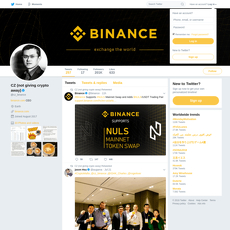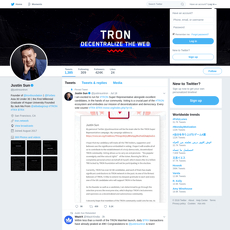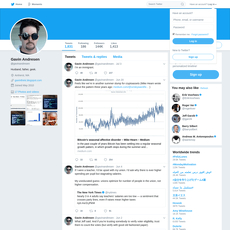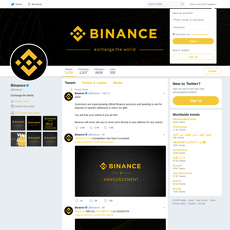Charlie Shrem Review
Charlie Shrem
twitter.com
Charlie Shrem review guide: everything you need to know + FAQ
Have you wondered if following Charlie Shrem on X/Twitter actually makes you a smarter Bitcoiner?
I’ve been tracking OG voices for years on Cryptolinks.com, and this guide breaks down what you’ll really get from Charlie’s feed, how to use it well, and what to watch out for. You’ll see why his long view on Bitcoin still matters, where his experience helps, and how to filter the noise so you don’t waste time or fall for hype.
Describe problems or pain
Crypto Twitter can be a mess. One minute it’s alpha, the next it’s outrage, and your feed swings from ETF rumors to “last chance to buy” hot takes in a few scrolls. With OGs, the signal is real—but so are the biases and blind spots.
- Signal vs noise: Timelines reward speed and emotion, not accuracy. A well-known study of Twitter showed false news spreads faster than true news because it feels more novel and emotional (MIT, 2018).
- OG baggage: Early builders (including Shrem) have history, deals, and relationships. That can enrich context—or color a take.
- Controversy hangover: Newcomers hear the name “Shrem” and remember headlines, not the full story. Old hands remember BitInstant but may not know what he actually posts today.
- Actionable > endless threads: You want something you can use: a sharper thesis, a security nudge, a sanity check—not a 30-tweet cliffhanger.
On top of that, too much scrolling leads to decision fatigue—more inputs, worse judgments (APA overview). If you’re trying to build and keep a long-term Bitcoin position, whiplash isn’t a strategy.
Promise solution
Here’s what you’ll get from me, fast and clean:
- A quick backstory for context (so headlines don’t mislead you).
- What Charlie actually tweets about now, in plain English.
- Why his perspective can help a holder or casual trader—and where it can’t.
- A simple, low-noise system to follow him without burning hours.
- Rapid-fire FAQs and links so you can double-check anything important.
No hero worship. No dunking. Just a practical read on whether—and how—his feed earns a spot in your week.
Who this guide is for
- Bitcoin holders who want fewer tabs open and a stronger long-term lens.
- Occasional traders who value context over calls.
- Builders and researchers who like first-cycle stories but hate hype.
- Anyone curious whether following a Bitcoin OG on X actually helps their setup.
What you’ll take away
- A clear snapshot of Shrem’s history and what he’s doing today.
- His long-term stance on Bitcoin’s future—including the “5–10 BTC in cold storage” idea you’ve probably heard about.
- How to spot the value in his posts (and the subtle red flags to ignore).
- A fast FAQ you can skim in under a minute, plus sources to keep you honest.
Quick sanity check example: If Charlie posts about institutional adoption, don’t stop at the headline. Click through, confirm the filing or on-chain data, and decide if it changes your custody, timing, or risk—not just your mood.
Ready to see why people still care about his perspective—and what that “BitInstant era” actually means for you today? Let’s start with the quick backstory next.
Who is Charlie Shrem? The quick backstory
Every few years, crypto crowns a new “expert.” Charlie Shrem isn’t one of those. He’s one of Bitcoin’s earliest builders who actually shipped things when getting BTC felt like contraband, not a ticker. He helped real people touch Bitcoin before the rails existed, paid a heavy price when the rules collided with the frontier, and came back with a clearer voice and a longer memory.
“We’re still early—but not as early as you think.”
Early Bitcoin days and BitInstant
Before slick mobile on-ramps and instant ACH, buying BTC was slow and messy. That’s where BitInstant—co-founded by Charlie—changed the game. It connected Bitcoin to cash registers and bank counters so everyday people could get BTC fast without waiting days for transfers to clear.
- What it did: Let you buy/spend BTC at 700,000+ locations via retail and payment partners, charging a fee and fronting short-term credit to speed things up.
- Why it mattered: In 2012–2013, exchanges were clunky, bank rails were suspicious, and weekends were a dead zone. BitInstant reduced friction when it mattered most.
- A real snapshot: You could walk into a shop on a Saturday, hand over cash, and have BTC show up fast instead of waiting until Tuesday for a bank transfer. That convenience pulled a lot of curious users over the line.
There’s a simple adoption truth that product managers and growth folks repeat because it’s true: reduce steps, increase conversions. In those early years, BitInstant was that step reducer. It didn’t just make Bitcoin easier—it made it feel possible.
The legal chapter (and lessons)
Charlie’s story also includes a hard stop. He pled guilty in 2014 to aiding and abetting unlicensed money transmission tied to Silk Road–era activity and served prison time. It’s an uncomfortable but critical part of his arc.
- The cost: Time served, reputation on the line, and the kind of introspection only a public fall forces.
- The shift: After release, he became far more vocal about compliance guardrails, custody, and personal responsibility—how to build for freedom without ignoring the rules of the road.
This is where a lot of people connect with him emotionally. He’s not just telling cautionary tales—he’s lived one. When he talks about risk, custody, or “don’t cut corners,” it lands differently.
“Not your keys, not your coins.”
What he’s doing now
Post-2016, Charlie took the builder’s curiosity and redirected it into investing, advising, and storytelling.
- Investor/advisor: Works with founders who are solving real problems—on-ramps, security, infrastructure—leaning on the bruises and wins from the early 2010s.
- Podcast host: His show “Untold Stories” digs into Bitcoin history, macro thinking, and the messy trade-offs builders face. Expect conversations with early operators and fund managers who were around before the buzzwords.
- Public voice: On X, he blends market context with “remember when” anecdotes and simple guardrails for newcomers. It’s less hot takes, more perspective.
If you’re mapping how narratives aged—mining FUD, exchange risks, institution vs. cypherpunk—his catalog is a useful time capsule. You can watch views evolve across cycles instead of pretending they were always obvious.
Why people still care
Longevity in Bitcoin isn’t about screaming the loudest; it’s about pattern recognition. Charlie has seen multiple cycles, from the hand-to-hand cash era to ETFs on mainstream brokerages. That kind of timeline gives you filters.
- Historical memory: He knows which panics tend to repeat and which structural upgrades actually change the game.
- Lindy lens: The longer something survives, the more likely it is to keep surviving. He brings that lens to Bitcoin infrastructure and narratives, which helps you separate short-term noise from real shifts.
- Human factor: The rise, the crash, the consequences, the rebuild—people relate to it. You can be bullish and still laser-focused on risk when you’ve lived both sides.
I’ve found that when an OG carries scars and curiosity in equal measure, you get better context. You don’t have to agree with every take for it to sharpen your own thinking.
So if that’s the person behind the handle, what does his X feed actually look like today—what shows up, how often, and where’s the real signal hiding? Let’s open that up next.
Inside his Twitter/X: what to expect, style, and signal
I keep a close eye on Charlie Shrem’s X feed because it’s one of the few places where you get long-memory context without the algorithmic panic. If you’ve ever panic-bought or panic-sold, you’ll recognize the value in someone who slows the pulse and focuses on first principles.
“Not your keys, not your coins.”
That line isn’t new, but it’s the drumbeat you’ll hear in different forms throughout his posts. It anchors everything else he talks about.
Types of posts you’ll see
- Macro Bitcoin threads: Clear, long-view explanations of why Bitcoin’s design tends to outlast cycles. Expect “zoom out” charts, halving context, and adoption curves rather than short-term calls.
- ETF and institution notes: When spot ETF flows spike or a new custodian gets approved, he’ll frame what it means for legitimacy and access. Less “go long now,” more “this reduces friction for the next wave.”
- Security and custody nudges: Friendly reminders to move off exchanges, rotate keys, and keep backups organized. You’ll see practical, bite-size cues that push you toward self-custody without scaring you.
- Founder spotlights and builder threads: He highlights projects and people he thinks are pushing useful infrastructure. The tone is “learn from this,” not “ape this.” If there’s a tie to his podcast, you’ll usually get an extra lesson or two.
- Early-days anecdotes: Short, story-style posts from the BitInstant era and the first boom-bust cycles. These aren’t nostalgia for its own sake; they’re pattern-matching tools to help you avoid old mistakes with new names.
- Regulation and policy commentary: Takes on how proposed rules hit onboarding, privacy, or custody. He’s been burned by bad rails before; you’ll feel that experience in the way he weighs trade-offs.
- Market structure quick hits: Notes on on-chain fees, mempool pressure, or miner behavior when it actually matters for holders. He’ll flag “this is noise” just as fast as “this could be sticky.”
- Podcast snippets with signal: Clips and quotes from “Untold Stories” that give you mental models you can reuse—like how builders survive regulatory cycles or why UX improvements quietly change everything.
When ETF headlines trend, for example, he’ll typically point at adoption gravity instead of price targets, and when a wallet exploit makes the rounds, he’ll push a simple checklist: update firmware, verify addresses, test a small send, then proceed.
Tone and frequency
Conversational, optimistic, and reflective. He posts most days without flooding your feed, and he tends to ramp up when the industry is at an inflection point. Replies aren’t rare—if a thread touches custody, regulation, or builder stories, he’ll jump into the comments and clarify. You won’t get doom-posting or victory laps; you’ll get “here’s why this matters in three bullets.”
It’s the kind of voice that says, “Take a breath, think like a steward, not a speculator.” And yes, that’s refreshing on X.
Where the signal is
- Zoomed-out frameworks: He returns to durable ideas—scarcity, permissionless access, self-sovereign custody—because those survive volatility. Research bears this out: frequent trading often underperforms a disciplined, long-term approach (see Barber & Odean, 2000), and his feed nudges you toward the latter.
- Historical parallels: He’ll map today’s narratives onto earlier cycles so you can separate recycled hype from real shifts. That memory is gold when everything feels “unprecedented.”
- Simple heuristics for holders: Think rules of thumb like “own some BTC, hold your keys, and let time work.” Not fancy, but durable.
- Signal over speed: In a world where false stories spread faster than true ones on social platforms (MIT/Vosoughi et al., Science 2018), a feed that slows you down and asks for sources is a competitive edge.
In practical terms, the best posts are the ones that change your setup, not just your mood—like a reminder to test your seed backup or a nudge to limit exchange exposure during high-fee spikes.
What to watch out for
- Bias and relationships: Any OG has friends, investments, and old rivalries. Treat conviction as a lens, not a buy/sell switch. If there’s a project mention, assume potential involvement until you check.
- Anecdotes aren’t data: Story-rich posts hit emotions; verify the numbers before you act. Open sources, look for multiple confirmations, and note what’s opinion versus fact.
- Timeframe mismatches: He thinks in years. If you’re thinking in hours, you’ll misread a calm macro take as a short-term signal. Align your horizon before you click buttons.
- Engagement traps (in general): Urgency, unsourced screenshots, and “act fast” vibes. He rarely leans on these, but X is full of them. If a claim can’t survive a two-link cross-check, it doesn’t deserve your money.
Quick reality check I use when one of his posts nudges me to act:
- Source: Is there a link to a filing, on-chain explorer, or a reputable dataset?
- Horizon: Is this a structural point (years) or a transient headline (days)?
- Custody impact: Does this change how I secure or store BTC right now?
Here’s a simple example. If he highlights a surge in ETF inflows, I’ll scan a trusted dashboard, read a fund’s daily creation/redemption note, and then ask: “Does this change my self-custody plan?” Usually, the answer is no—but it may confirm why I’m sticking to it.
So, what happens when that long-term drumbeat meets a market that’s accelerating—are we still talking decades, or has the clock really sped up? Let’s look at the exact mindset he’s been sharing lately and how to use it without overthinking the day-to-day.
His view on Bitcoin’s future (and what you can use right now)
I’ve watched Charlie Shrem keep one message steady through multiple cycles: Bitcoin is a multi-decade bet that rewards patience and self-custody. Lately, he’s been saying the same outcome might arrive sooner than expected — that the “long run” is getting pulled forward by cleaner rails and bigger players showing up. If you’ve ever wondered whether you’re too early or too late, his lens helps you stop second-guessing and start tightening your setup.
“The timeline is accelerating.”
That line hits because it matches what many of us feel: the crypto story is moving from the fringe to the front page. And when the clock speeds up, execution matters more than theory.
The “5–10 BTC in cold storage” idea
For years, Shrem has floated a simple mental model: if you can hold 5–10 BTC in cold storage for ~20 years, it could be “super life-changing.” It’s not a prescription; it’s a north star. The point isn’t the exact number. It’s the behavior behind it:
- Own real Bitcoin (not IOUs), and keep it off exchanges.
- Think in decades, not days. Let time carry the compounding of adoption.
- Minimize unforced errors (bad custody, leverage blowups, chasing hype).
He’s recently added that this transition feels faster than he expected. That claim doesn’t live in a vacuum — it’s supported by what we’re seeing in the market structure and mainstream rails.
Why he thinks the clock sped up
- Spot ETFs unlock mainstream demand: U.S. spot Bitcoin ETFs went live in 2024, giving pensions, advisers, and compliance-bound institutions a clean wrapper to allocate. This isn’t about trading tickers; it’s about policy and plumbing. See background on the milestone here: Bitcoin ETF overview.
- Cleaner on-ramps: The friction from “I’m curious” to “I own Bitcoin” keeps shrinking. Cash App, PayPal, and major brokerages made buying simpler, while regulated trusts and ETFs made allocation acceptable in boardrooms.
- Sovereign signals: El Salvador proved a nation-state can hold Bitcoin on its balance sheet and make it legal tender. Whether you agree with its policy or not, it normalized a once-unthinkable step. Context: El Salvador’s Bitcoin Law.
- Institutional balance sheets: Public companies holding BTC changed the narrative from “speculative toy” to “treasury asset.” That shift has staying power because it’s visible, auditable, and hard to walk back without headlines.
- Better UX and security: Hardware wallets, multisig services, and wallet standards have matured. A non-technical user can now set up secure cold storage in an afternoon. Multisig education has moved from niche forums to mainstream guides (example: multisig explained by Unchained).
- Adoption data keeps trending up: Independent reports show consistent grassroots usage beyond bull cycles. Chainalysis’ Global Crypto Adoption Index has documented steady retail interest across emerging markets, even during price drawdowns (2023 report, 2024 coverage). On-chain analytics also track a long-term rise in non-zero BTC addresses (check Glassnode).
If you connect those dots, you get why Shrem leans into time horizons. Less friction means adoption compounds faster, and faster compounding shrinks the waiting period for the “life-changing” moment.
How to apply this mindset
Here’s how I translate Shrem’s long-view into a practical, low-stress playbook you can start today:
- Set your thesis in one sentence: “I hold Bitcoin for 10–20 years as a scarce, bearer digital asset that could become a neutral settlement layer.” Tape this somewhere you see it when markets get loud.
- Pick an allocation rule you can sleep with:
- Automate buys on a cadence (weekly/monthly) to avoid second-guessing.
- Auto-withdraw to cold storage after each purchase or on a monthly schedule.
- Upgrade custody this weekend (90-minute checklist):
- Use a hardware wallet (Ledger, Trezor, Passport, Keystone — your pick).
- Create a fresh seed and add a passphrase. Write both by hand, twice.
- Store backups in two separate locations. Consider a steel backup for one.
- Send a small test transaction, then a larger one after verifying addresses.
- Do a full recovery test on a spare device or emulator before funding heavily.
- If your stack grows, consider 2-of-3 multisig with geographically separated keys.
- Remove blow-up risk:
- No leverage unless you can afford a total loss of the leveraged portion.
- No custodians you wouldn’t feel okay losing access to for a month.
- No “earn” products that rehypothecate your coins without clear, audited risk.
- Use his posts as prompts, not trades: When Shrem mentions ETFs, custody, or adoption, treat it as a nudge to update your setup — not to time a buy. Examples:
- Mentions of security → schedule a 30-minute seed-phrase check and recovery test.
- Notes on institutions → review your allocation and rebalance rules calmly.
- Historical context → archive the thread, add a tag (e.g., “macro” or “security”), and decide one tiny action to take.
- Plan for real life: Document an inheritance plan (who, what, where, how), add 2FA with a hardware key on your email and exchange logins, and keep a yearly calendar reminder to test your recovery and refresh your notes.
“If Bitcoin works, time is your edge. Protect it.”
I keep coming back to this because it’s equal parts rational and emotional. The rational side is rails, policy, and product-market fit. The emotional side is staying calm enough to let compounding do its thing. If the timeline is really accelerating, the winners won’t be the loudest traders — they’ll be the quiet ones who set smart defaults and stopped fiddling.
Want a simple, 10-minute weekly routine to catch Shrem’s best posts and ignore the noise? Let’s set that up next — it’s the exact system I use so I don’t live on X all day. Ready to steal it?
Follow-along guide: make the most of his feed in minutes a week
I don’t want you doom-scrolling. I want you grabbing the signal from Charlie Shrem’s Twitter/X, putting it to work, and getting on with your life. Here’s the setup I use that keeps me informed in under 15 minutes a week.
“Signal is what changes your setup; noise is what changes your mood.”
Setup that saves time
Build a lightweight filter that catches the good stuff and skips the rest.
- Create a “Bitcoin OGs” List on X and add Charlie Shrem plus 5–10 steady voices. Lists beat the main feed, which is tuned for engagement, not clarity.
- Use notifications wisely: tap the bell on his profile and choose Highlights (or set mobile push for the List, not for all tweets). You’ll avoid ping overload and still catch the important posts.
- Mute words that waste time: “airdrop,” “giveaway,” “100x,” “signal group.” This keeps your List clean. X > Settings > Privacy and Safety > Mute and block.
- Batch your check-ins: one weekly session. Research from UC Irvine’s Gloria Mark shows it can take ~23 minutes to refocus after interruptions—batching beats constant peeking.
- Use advanced search when you’re short on time:
- from:CharlieShrem min_faves:100 -is:reply — surface his most-engaged posts
- from:CharlieShrem filter:links — find posts with sources
- from:CharlieShrem since:2024-01-01 “custody” OR “multisig” — pull security-focused content
Why this works: X’s algorithm rewards controversy; Lists and searches reward curation. You get context without the cortisol.
Cross-check and archive
Good habits turn a tweet into an upgrade to your setup.
- Tap through the source on any stat or claim. If it’s ETF flows, look for the issuer’s dashboard or a reputable tracker. A 2018 MIT study found false news spreads faster than true news on Twitter—verify before you act.
- Save for action, not for later guilt:
- Bookmarks for quick personal saves (use folders if you have Premium)
- Thread Reader to unroll longer posts into a single page you can read once
- Read-it-later app like Omnivore or Readwise to tag “Security,” “Markets,” “Builders”
- Add a one-line note when you save: “Enable passphrase on hardware wallet this weekend.” Tiny notes turn intent into follow-through.
- Cross-check sentiment with one neutral chart. If he mentions “institutions stepping in,” glance at ETF net flows or on-chain exchange balances. One minute. No drama.
Real-life sample workflow: he mentions tightening self-custody? I open my hardware wallet docs, review my recovery process, and schedule a 10-minute test restore on Sunday. If he flags a regulatory shift, I note its impact on my on-ramps and update my plan, not my emotions.
Green flags vs red flags
Quick gut-checks help you keep your brain calm and your stack safe.
- Green flags
- Links to primary sources: filings, dashboards, original research
- Security nudges: cold storage, multisig, key hygiene, test restores
- Consistent long-term framing over short-term hype
- Clear disclosures when discussing projects or founders
- Red flags
- Urgency language: “last chance,” “don’t miss,” “act now”
- Unsourced numbers or screenshots with no link
- Pressure to join groups, signals, or click referral links without context
- Overconfidence on short-term price calls—great storytellers aren’t always great timers
Your 12-minute weekly playbook
- Minute 0–3: Open your “Bitcoin OGs” List. Scan Charlie’s last week. Star only posts that could change your setup.
- Minute 4–7: Open two links max. Verify the primary source. If it’s not clear, skip.
- Minute 8–10: Save one thread with a one-line action note (e.g., “move 10% to cold,” “review multisig guide”).
- Minute 11–12: Calendar one step. If it’s not scheduled, it’s not real.
Tiny discipline beats endless scrolling. This is how I get the most out of Charlie Shrem’s feed without letting it run my day.
Want the exact links to his profiles, background, and the podcast episodes that best show how his thinking evolved? I’ve got a short list queued up—which ones do you want to check first: official sources or deeper interviews?
Handy links if you want to go deeper
If you want context without getting lost in tabs, here are the few places I check first, plus how I use each one so the time actually pays off.
Official profiles and background
- X/Twitter: https://twitter.com/CharlieShrem
How I use it: Look for long-horizon posts (self-custody, adoption, macro shifts) and any threads he pins. When something sounds actionable (security tweak, custody reminder), I bookmark it and add a one-line note so I remember why it mattered. - Wikipedia overview: https://en.wikipedia.org/wiki/Charlie_Shrem
How I use it: Quick scan of the timeline: early entrepreneurship, BitInstant, the legal chapter, then post-release investing and media. It’s the fastest way to understand what shaped his current views on compliance and custody. If you’re new, read this before weighing any hot take on your feed.
Coverage and summaries
- altFINS summary touching his long-term BTC thesis: https://altfins.com/crypto-news/crypto-news-summary/20832
Why it’s useful: It gives you a neutral pass at the “multi-decade bet” mindset and the idea that adoption is accelerating thanks to cleaner rails and institutions. I use this kind of third-party snapshot to sanity-check what I’m seeing across X—less hype, more pattern recognition.
Podcast and projects
- “Untold Stories” podcast (interviews with early builders and investors)
What to listen for: origin stories, early trade-offs, and how veterans changed their mind across cycles. I tag episodes in my notes by theme—custody, regulation, UX, macro—so when a headline hits (ETFs, compliance shifts, self-custody alerts), I can jump back to the most relevant conversation and apply a lesson.
Quick tip: Sort for episodes featuring founders who shipped during the 2011–2014 era. Those interviews tend to reveal the “why” behind today’s best practices (cold storage, minimizing trusted third parties).
Power move: When you hear a strong claim on the podcast or X, pair it with a timestamped note and one external source you trust. Over time, that becomes your personal “Bitcoin playbook” instead of a pile of bookmarks you’ll never open.
Want to know if all this actually adds up to a follow that’s worth your time—or just another voice in the noise? I’ll answer the question everyone asks next…
FAQ and final take: is Charlie Shrem worth your follow?
This is the quick-hit section I wish more people had before hammering the Follow button. I’ll keep it tight, give real examples, and point to sources you can check in two clicks.
What are Charlie Shrem’s thoughts on the future of Bitcoin?
Long-term bullish, very self-custody focused, with a simple thesis: own some BTC you can actually control, and let time work. He’s talked for years about the “5–10 BTC in cold storage for the long run” idea—and lately he’s said the timeline feels faster than he expected.
Why “faster”? Because trust rails improved:
- Spot Bitcoin ETFs pulled in steady institutional demand in 2024, with tens of billions in AUM and persistent net inflows you can track on Farside’s ETF flow dashboard and CoinShares’ weekly flow reports.
- Cleaner on-ramps and custody make it easier for newcomers to buy and hold without wrestling clunky UX.
- Macro narratives (inflation, sovereign interest) keep Bitcoin in the mainstream conversation, which tends to compound adoption in cycles.
My read when he posts about this: it’s not “number-go-up tomorrow,” it’s “the pipes are built—accumulation and patience win.”
What was BitInstant?
A bridge from fiat to BTC in Bitcoin’s earliest days, co-founded by Shrem. It let users buy/spend BTC across 700,000+ locations and fronted short-term credit to speed things up when exchanges were slow. In that era, convenience was adoption. If you want a quick refresher, the Wikipedia summary covers the arc without the nostalgia goggles.
Is he a reliable source?
For context and frame, yes. For precise entries, trade signals, or single-source statistics, no. I treat his posts as prompts to research, not orders to act.
- Use him for: long-view thinking, historical pattern-spotting, security reminders, which headlines actually matter.
- Cross-check specifics: ETF flows (see CoinShares), on-chain activity (see mempool.space), and any stat he cites by going to the original source.
If a post sounds urgent or number-heavy without links, pause and verify. It’s not just him—this applies to every OG.
Does he still build or invest?
Yes. He invests, advises founders, and hosts Untold Stories, where early builders and long-time operators talk shop. It’s useful for seeing how his thinking evolved across cycles—and which sectors he’s actually watching.
What can I learn from following him?
- A cleaner Bitcoin mental model: focus on self-custody, time horizon, and structural adoption (not daily noise).
- Better security habits: nudges to rotate keys, test backups, and simplify setups. The reminders sound basic until they save you.
- Signal filters: separating real infrastructure upgrades (ETFs, custody, payments rails) from hype that fades next week.
When the US ETFs went live in early 2024, for example, the loudest takes were about one-day price spikes. Shrem kept pointing at the rails: who can buy now, how easily, and how that compounds over years. That’s the lens I value.
Any caveats?
- Bias happens: friendships, investments, old rivalries—it’s the industry. Treat conviction as a lens, not a to-do list.
- Never outsource custody or thinking: FTX was a brutal reminder. If it isn’t your key, it isn’t your coin.
- Watch the language: urgency, unsourced claims, or “act now” wording are your cue to slow down and double-check.
If you want broader risk context, the Chainalysis 2024 report is a solid reference for where losses actually happen (and how to avoid the common ones).
How I use his feed: If a post changes my setup, I save it, verify the source, and schedule a fix. If it’s just noise, I scroll. Time is the edge.
My quick verdict
Yes—worth a follow if you want a seasoned, long-term lens on Bitcoin without constant hype. Pair his historical memory with your own checks, keep your BTC in secure self-custody, and let time—not tweets—do the heavy lifting. If you ever feel pressured or rushed by a post (his or anyone’s), stop, verify, and act on your schedule.
Want an easy system? Put him in a “Bitcoin OGs” List, skim once a week, and bookmark only the posts that improve your security or sharpen your thesis. That’s how you get 90% of the value in 10% of the time.
CryptoLinks.com does not endorse, promote, or associate with Twitter accounts that offer or imply unrealistic returns through potentially unethical practices. Our mission remains to guide the community toward safe, informed, and ethical participation in the cryptocurrency space. We urge our readers and the wider crypto community to remain vigilant, to conduct thorough research, and to always consider the broader implications of their investment choices.













